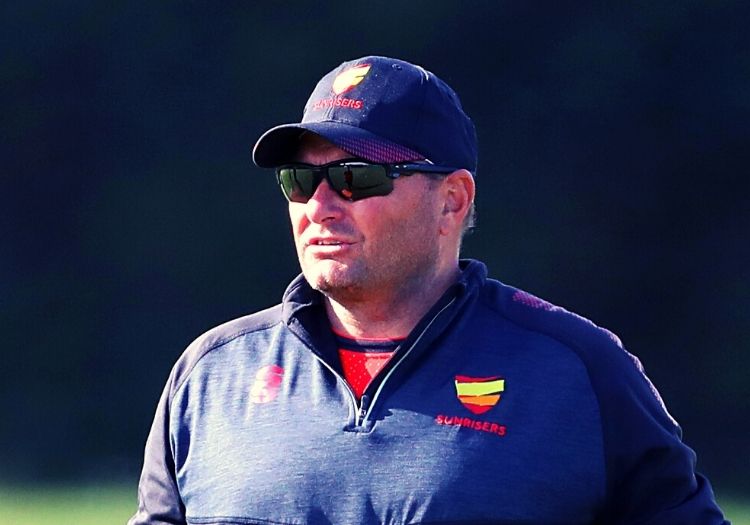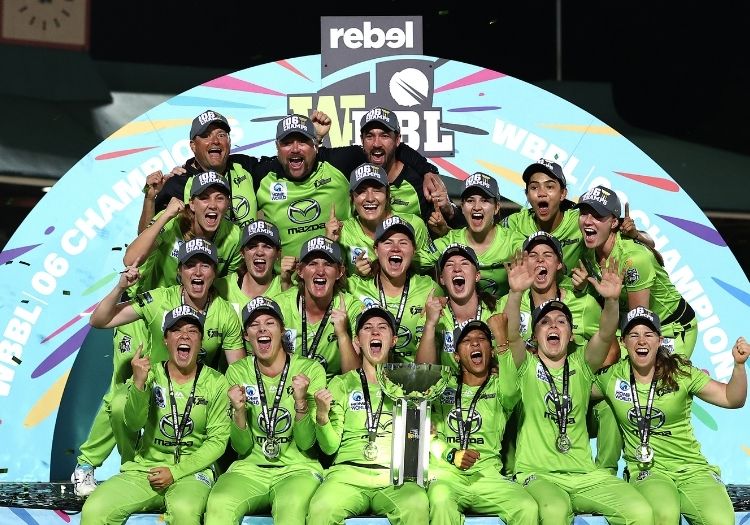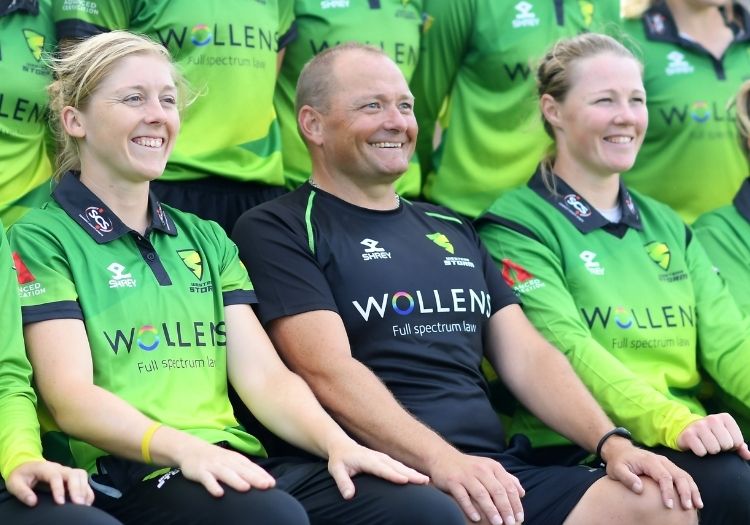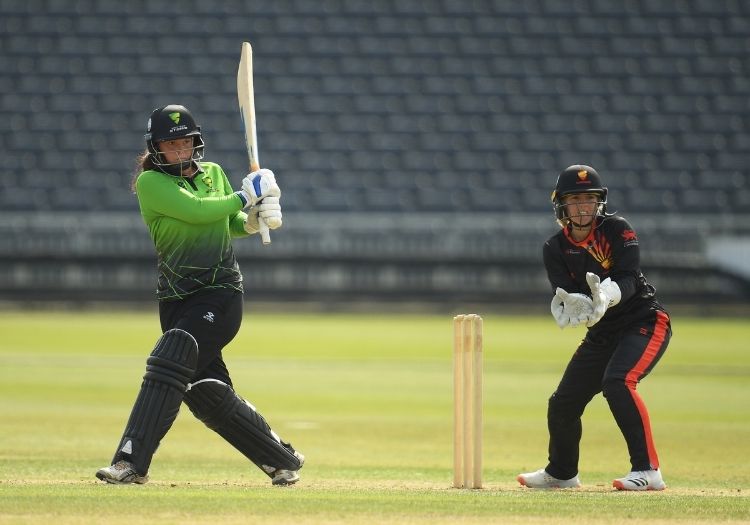NICK FRIEND: After coming into coaching through an unconventional route, Griffin has become a serial winner - first with Western Storm, latterly with Sydney Thunder. He opens up on his path into the game and a philosophy that has bred success

What kind of coach is Trevor Griffin?
“That’s a really good question,” he laughs, before pausing for a moment’s reflection. It is a straightforward enough query, but also one that requires a deeper, personal response.
“In a nutshell, for me it’s all about creating the right environment for these players to go out and achieve their dreams.”
Griffin is fascinating company: one of the most impressive, in-demand figures in the women’s game and a gun for hire on the fledgling franchise circuit as a Kia Super League winner with Western Storm and most recently a Women’s Big Bash champion with Sydney Thunder. His move to head up the Sunrisers regional hub, spanning nine counties – from Middlesex and Essex to Norfolk and Huntingdonshire – was an intriguing career shift and a different challenge to the kind he faced in those previous title-searching roles. Sunrisers have a young, inexperienced squad and are constructing an infrastructure from scratch, whereas several of their new rivals are able to build on systems put in place through the KSL.
But taking the unexpected path with a longer-term goal in mind is nothing new for a former employee of Nationwide Building Society, who left his job to make good on his “passion for people development” and a lifelong love of cricket. That was in 2007, and everything since has been of his own doing, charged by his own motivation, “throwing myself into every opportunity I had”.
Until then, Griffin was on a similar journey to the rest of us who make club cricket the centrepoint of our summers: a promising junior who represented Essex at age-group level, before arriving at the realisation that he would not make it as a professional athlete. On Saturdays, he made it as far as Essex’s Premier League while working his weekdays in a corporate environment, until a promotion saw him relocate to Cornwall and then onto Devon, where he played for Whimple Cricket Club and Ottery St Mary.
He explains: “I found that I couldn’t play to the level that I wanted to because of work and coaching, and where I got most of my enjoyment wasn’t through playing – but actually through coaching.”

Trevor Griffin (top left) celebrates winning the Women's Big Bash with his Sydney Thunder side
So, he quit his normal job and followed his heart. A coaching career was raised from the ground up, founded on “putting myself out there a lot”: he volunteered at elite player programme (EPP) level and jumped at other opportunities, working for a period as a coach with Chance for Shine and, separately, for the Devon Cricket Board; after his father passed away, he used some of his inheritance to fund a trip to New Zealand, where he worked with Canterbury Cricket.
There, he met current national team head coach Gary Stead and “built some fantastic relationships”. He repeated that trip on two further occasions: on one, he was introduced to Giles White, Hampshire’s director of cricket, and Somerset head coach Jason Kerr. Through those connections, he spent a week with Hampshire and would have done the same with Somerset had the dates worked out. Instead, Kerr has been “at the end of the phone” to pass on any advice.
That was the build-up to where he is now, seen as a coup for Sunrisers and later this summer leading London Spirit into the inaugural edition of The Hundred as the women’s equivalent to Shane Warne. It is a long way from Whimple.
The reason for recounting that anthology of work is to highlight Griffin’s resourcefulness – the same characteristic that shines through as he describes his own coaching philosophy.
“Whatever I do, it’s always about the individual,” he says. “That comes from building relationships and understanding what they need to help them get better.
Mark O'Leary is all about the player
“Do we need to play more games to help us get better? Well, yes, we do. So, how can I create an environment that is more game-based if we can’t get opposition because of Covid and the various protocols?”
Some of the answers to those questions lie in his background. “I think it’s quite easy to get caught within the cricket bubble or sporting bubble,” he reflects. “I’d like to think that I have a slightly different perspective on things, having worked in the corporate world.”
He has experienced his own versions of the difficulties and dilemmas facing the female domestic cricketers of today, with the revamped structure moving towards professionalisation. Naomi Dattani, Cordelia Griffith, Amara Carr, Jo Gardner and Kelly Castle are Sunrisers’ five players now under full-time contracts, while their teammates continue to juggle commitments.
“Some of these players do have to earn a living and have to have a full-time job, so how do we balance all of that?” Griffin asks. “I think the ability to understand the pressures of work and life – I’d like to think I have a bit more empathy around that side of things, and I can also understand how to support them.
“I think within sport, a lot of things get done for players – whether that’s cricket, football or anything else. There is a lot of support available – you turn up to a training session and the cricket nets are there for you and the balls are all set out. You turn up to work and you have to make your own cup of tea and work through your own stuff. They are different challenges; if you’ve always been in cricket and you’ve never experienced those things, they’re new to players – how you organise your life.”

Sunrisers have an inexperienced squad but a title-winning coach
Once upon a time, Griffin was new to this – an outsider, as it were, operating in elite sport as an analyst and assistant to Caroline Foster at Western Storm in the KSL’s first year. The following season, he took over as head coach and Storm raced to the title. Any would-be sceptics were immediately allayed, watching on as he built a winning CV despite a lack of top-level playing experience.
“When there are comments about having not played the game, there are numerous examples out there,” he points out, namechecking Butch Harmon, the former coach to Tiger Woods and Phil Mickelson and “a pretty average golfer”, fellow renowned swing coach David Leadbetter and football manager Jose Mourinho. “Even Mike Hesson, the former New Zealand coach, didn’t play international cricket.”
Whether Griffin noticed any doubts from external forces commenting on the legitimacy of his credentials, he is unsure. “But I certainly felt internally that there was a point to prove,” he says.
“When I worked as a Chance to Shine coach for a few years, I remember a comment being made when I was expressing how I wanted to progress as a coach. I can remember being told that there was nothing wrong with being a Chance to Shine coach and that I should bear in mind that I’d never played the game.
VISIT THE WOMEN'S REGIONAL HUB
“I think there are pros and cons with regards to having played the game or not. As a head coach, I’m not 100 per cent sure as to whether that’s necessarily needed if you surround yourself with the right people.”
In Griffin’s case, the right person was Michael Bates, the former Hampshire wicketkeeper who retired from playing aged just 25 and is now highly regarded as a coach, working with England Women, having begun as assistant to Griffin at Western Storm.
“He brought that knowledge of having played the professional game,” says Griffin. “And then there was me, having worked in the corporate world; I was bringing a skillset that he didn’t have. I think that was why we worked so well together and complemented each other.
“Quite often – and I saw this in my previous job as well – the best performers don’t necessarily always make the best coaches. Because their skill is so innate, they’re sometimes not able to articulate it and they’re maybe not able to help other people perform in their game because they can’t relate to it. I’m not saying that because you’ve played the game, you won’t make a good coach. I’m not saying that at all, but sometimes the high performers find it quite hard to articulate what they did.”

Griffin enjoyed a successful stint as head coach of Western Storm
One of the major draws for Griffin in taking up his latest role was precisely that: believing that he could make a difference: “It’s a different challenge, but there are so many similarities to the first year of the KSL. That’s one thing I’ve been saying to the staff: some of the challenges that we’ve been experiencing are exactly the sort that we saw in the Kia Super League. We’re learning as we go along.”
He cites the example of regional development centres, which have already been in place at some of the hubs that have evolved out of their KSL predecessors. “They have been able to develop the younger players,” he explains. “We haven’t had the benefit of that. There has been some coming together of the counties previously to do things like a regional development centre, but it hasn’t been in the same vain as the KSL teams.
“It’s really exciting to see how we can grow. There is some untapped potential in this region within the younger age-groups now linked to our academy. But also, some of the older players that perhaps have been missed from the Kia Super League as well.”
Falling in love again: Alex Hartley has her buzz back after two tough years
The upshot is that Griffin sees a blank canvas. In March, Sunrisers were able to use the net marquee at Merchant Taylors School, where Middlesex’s men train through the winter, as part of their pre-season preparations.
His major bugbear remains the shortage of competitive cricket played in the domestic women’s game, so the revamped structure represents a significant improvement, with the Rachael Heyhoe Flint Trophy, Regional T20 and The Hundred giving the look of a packed schedule, and the county game still functioning underneath.
The nature of this year’s calendar is such that the county T20 competition has acted as useful groundwork for what is to come, with several games already played and valuable match practice banked. In Griffin’s ideal world, it would have been 50-over cricket, given the order of the regional summer. But Sunrisers are fortunate that the formation of the London Championship – a 50-over competition comprising Essex, Kent, Middlesex, Surrey and Sussex – will give the majority of their players further action.
He has arranged loan deals for some of his players to maximise those opportunities: Lissy MacLeod, who represents Berkshire, has missed out on their T20 campaign due to work commitments, so has agreed to join Essex for that tournament, while Jo Gardner plays T20 cricket for Warwickshire, who have no plans for any 50-over games, and has also joined Essex for the longer format.

Amara Carr (keeping wicket) will captain Sunrisers this year
The question, then, is simple: what constitutes success? Griffin’s background, after all, is in winning trophies. With both Western Storm and Sydney Thunder, he forged a close relationship with England skipper Heather Knight, while Rachael Haynes – a significant part of Australia’s all-conquering unit of recent years – was his captain for Thunder’s victory last November.
He recalls a conversation with Danni Warren, Sunrisers’ director of women’s cricket, in which he laid out his thought process: “I said to her that I’ve never really got hung up about the end column of wins and losses. For me, it’s more about the way we play the game. If we are playing to our full potential and executing our skills in the right way, the results will look after themselves. In terms of our successes this year, absolutely we go out to win and we go out to compete in every game that we play. But what I’m looking for is for those players to take their learning out into the middle.
“The bigger picture isn’t just the wins and losses – it’s how many of our academy players develop to come into the senior environment, how many of the senior players can we develop to go onto the England academy, England A and ultimately England? This, for me, is what it’s all about. How do we make England stronger?”
Vaccines, Vipers and me: Ella Chandler isn't your typical 20-year-old
He has seen it in Australia, where he has worked with Phoebe Litchfield and Hannah Darlington, two of the most promising teenagers in the global game.
“I often get asked what the difference is between Australia and England,” says Griffin. “I honestly believe there isn’t a huge amount of difference below international level – in the WNCL (Women’s National Cricket League) over there, they only actually play [eight] 50-over games. But they train a lot.
“Over here, before we had the regional structure, unless you were in the Kia Super League you probably didn’t get the volume of coaching and there wasn’t the volume of games, so they lacked the game sense. Now that they’re getting more training with the regional structures, we’re seeing the skill levels improve. It’s just that the volume of cricket that we play is still quite low. The skill level in Australia is slightly better just because they train a bit more, but the game sense isn’t too different.”
Griffin has been encouraged, then, by what he witnessed through the winter as Sunrisers’ first tranche of full-time, domestic cricketers developed their games ahead of a summer where their individual performances will come in for a level of scrutiny they have never faced before.
He adds: “The quality of conversations that I hear at training now are just at a completely different level compared to where we started: the clarity around their field settings, what they’re trying to do as bowlers and conversely as batters, how they’re trying to manipulate the field, where they see their boundary options and how they are going to look to get off strike.
“They’re talking cricket. That’s a really big shift that I’ve seen over the winter – it’s the quality of conversations that they’re having.”
As for dealing with the pressures of being professionally contracted, he is quick to praise the Professional Cricketers’ Association for their work in talking new members through the challenges and responsibilities they might face “with social media and things like that”.
In a youthful squad, Griffin is wary of the absence of an experienced leader to oversee that process – “we don’t have somebody who has played for England and is coming towards the end of their career” – and he knows as a result that much of his players’ education will come on the job.
“These girls are learning what it means to be a professional cricketer,” he explains. “That doesn’t just happen overnight. All of a sudden, they sign a contract and they’re a professional cricketer. But they don’t flick a switch – they have to learn and we will help them with that. We have to show them the way and what some of this means for them.”
Sunrisers have enlisted the help of Kate Green, described on the club’s website as a ‘psycho-social lead’, to work with the squad on their off-field and mental skills.

Rachael Haynes was Griffin's captain at Sydney Thunder
“It is a challenge for them; now that players are getting paid money to perform in their sport, alongside that is an expectation level – and people will comment,” adds Griffin.
He came across that kind of scrutiny for the first time in his very first game as Western Storm head coach – a chastening defeat at the Ageas Bowl against Southern Vipers back in 2017 in a game played out in front of an almost-packed ground as the first half of a doubleheader later featuring Hampshire men’s T20 Blast win over Glamorgan.
After his side were bowled out for just 70, Holly Huddleston – the former New Zealand seamer and one of three overseas players in the side – bowled two overs at a cost of 38 runs, including five no-balls.
“The game was over very quickly,” Griffin recalls, “and the social media response was quite brutal to it. That was the first time that I’d experienced that. It’s probably something I can relate to the players with. But with being professionals and earning money comes responsibility – not only on the social media side, but we’re paying them a salary to do a job. That is their job.
“If they’re not scoring runs or taking wickets, all of a sudden that’s a new dimension that they won’t have experienced. All we can do with that is support and educate them in the best way we can.
For 41 female cricketers, the professional dream has become a reality
“I can remember (Australia coach) Matthew Mott talking about Alyssa Healy; she had a loss of form, but he just said that she was hitting the ball well and they weren’t going to change it. They just kept on reinforcing confidence in her, and that’s no different to these girls – just reminding them of the processes that they have. Are they still doing those processes? Within training, are they still being very specific with their training?
“It’s about encouraging them to continue doing what they’re doing. The downside to things like a loss of form is that there is a real panic, where people feel like they have to hit more balls or bowl more balls.
“In essence, sometimes it’s better for them to have a bit of a break, clear their mind, go away and come back into the environment and start again. That goes back to what I’m about, which is doing what’s right for an individual. If the best thing for that person at a particular time isn’t hitting more balls but is going for a coffee and having a chat, then that’s what we’ll do. These are all new things that these girls are going to be experiencing.”
That’s The Trevor Griffin Way. Under his guidance, like with Western Storm and Sydney Thunder before, it would be little surprise to see Sunrisers thrive – the latest team to be sprinkled with a stardust he has developed on his own.